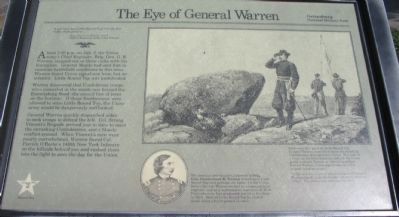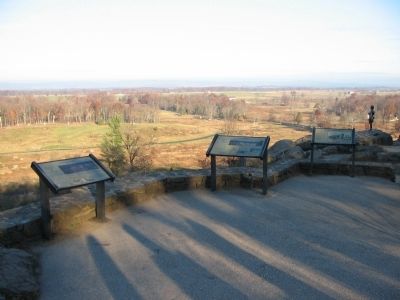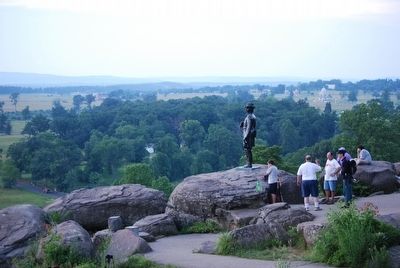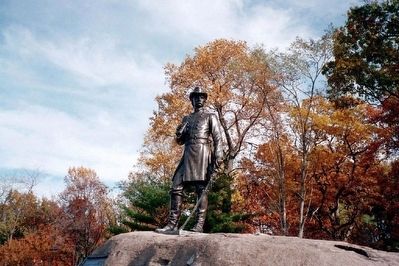Cumberland Township near Round Top in Adams County, Pennsylvania — The American Northeast (Mid-Atlantic)
The Eye of General Warren
July 2, 1863 - Second Day
Brig. Gen. G.K. Warren, U.S.A.
Chief of Engineers, Army of the Potomac
About 3:30 p.m. on July 2, the Union army's Chief Engineer, Brig. Gen. G.K. Warren, stepped out on these rocks with his binoculars. General Meade had sent him to examine battlefield conditions in the area. Warren found Union signalmen here, but no infantry. Little Round Top was undefended.
Warren discovered that Confederate troops were concealed in the woods just beyond the Emmitsburg Road (the second line of trees on the horizon). If these Southerners were allowed to seize Little Round Top, the Union army would be dangerously outflanked.
General Warren quickly dispatched aides to seek troops to defend the hill. Col. Strong Vincent's Brigade arrived just in time to meet the onrushing Confederates, and a bloddy conflict ensued. When Vincent's men were nearly overwhelmed, Warren found Col. Patrick O'Rorke's 140th New York Infantry on the hillside behind you and rushed them into the fight to save the day for the Union.
Erected by Gettysburg National Military Park.
Topics. This historical marker is listed in this topic list: War, US Civil. A significant historical date for this entry is July 2, 1814.
Location. 39° 47.534′ N, 77° 14.2′ W. Marker is near Round Top, Pennsylvania, in Adams County. It is in Cumberland Township. Marker can be reached from Sykes Avenue, on the left when traveling north. Located at stop 8, Little Round Top, on the driving tour of Gettysburg National Military Park. Touch for map. Marker is in this post office area: Gettysburg PA 17325, United States of America. Touch for directions.
Other nearby markers. At least 8 other markers are within walking distance of this marker. The Union Fishhook (here, next to this marker); The Valley of Death (a few steps from this marker); 91st Pennsylvania Infantry (a few steps from this marker); The Deadly Sharpshooters (a few steps from this marker); 91st Pennsylvania Volunteer Regiment (a few steps from this marker); Battery D Fifth U.S. Artillery (within shouting distance of this marker); Warren (within shouting distance of this marker); Signal Corps U.S.A. (within shouting distance of this marker). Touch for a list and map of all markers in Round Top.
More about this marker. On the right center of the marker is a drawing of the activities on Little round top. From near this point on Little Round Top, General Warren scans the horizon for attacking Confederates of Longstreet's Corps. The sight of a large enemy force about to outflank the Union position struck Warren as "almost appalling." Behind Warren, Union signalmen use a flag to send coded messages.
Visible in the front of
you is a bronze figure of General Warren standing on the boulder where he stood on July 2. The statue was dedicated in 1888.
On the lower center is a portrait of General Warren. The keen eye and decisive judgment of Brig. Gen. Gouverneur K. Warren helped save Little Round Top - and perhaps the battle - for the Union. Before the war Warren worked as a topographical engineer, and as a mathematics instructor at West Point where he had graduated second in his class in 1850. Here at Little Round Top he eluded death when a bullet grazed his neck.
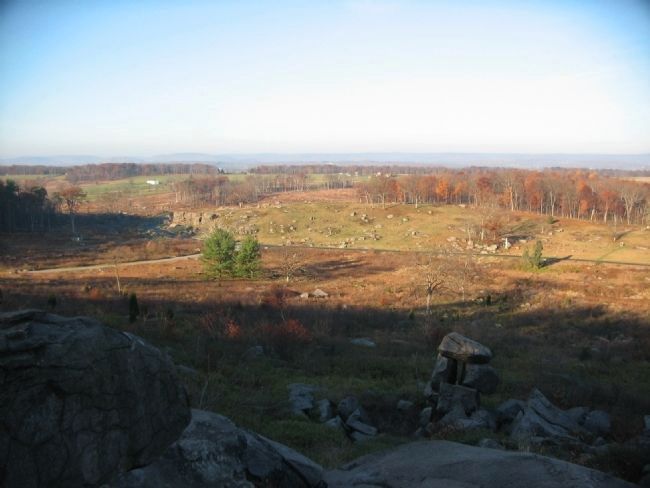
Photographed By Craig Swain, November 11, 2008
3. What Warren Saw
Looking west from Little Round Top. The first ridge line (and tree line) is Houck's Ridge, with the Devil's Den to the left. Beyond that are fields only recently cleared and restored to the wartime appearance. The distant tree line is along Warfield Ridge. Emmitsburg Road passes the ridge at the break in that tree line, just left of center. In the afternoon of July 2, 1863, Warren observed Confederates from Hood's and McLaws' Divisions forming on that ridge.
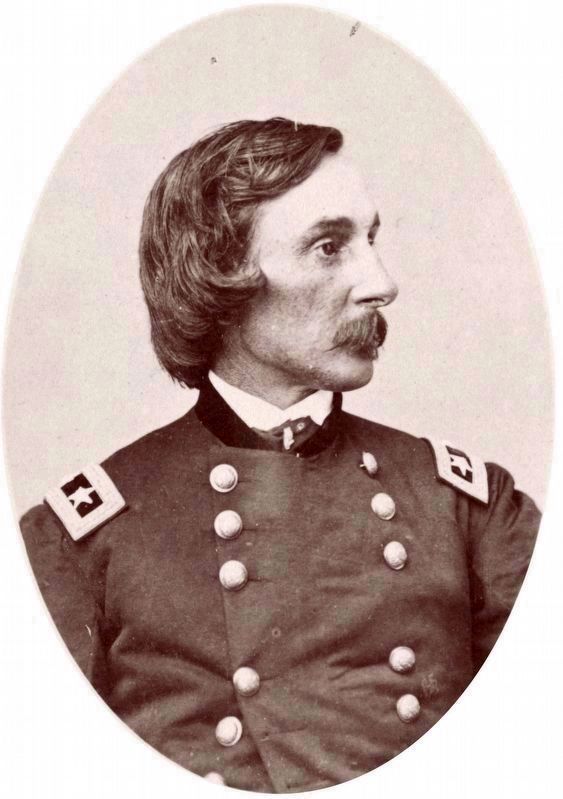
Library of Congress
4. Brig. Gen. Gouverneur K. Warren
The keen eye and decisive judgment of Brig. Gen. Gouverneur K. Warren helped save Little Round Top - and perhaps the battle - for the Union. Before the war Warren worked as a topographical engineer, and as a mathematics instructor at West Point where he had graduated second in his class in 1850. Here at Little Round Top he eluded death when a bullet grazed his neck.
Civil War Photograph Collection (Library of Congress). LC-B813-1757.
Civil War Photograph Collection (Library of Congress). LC-B813-1757.
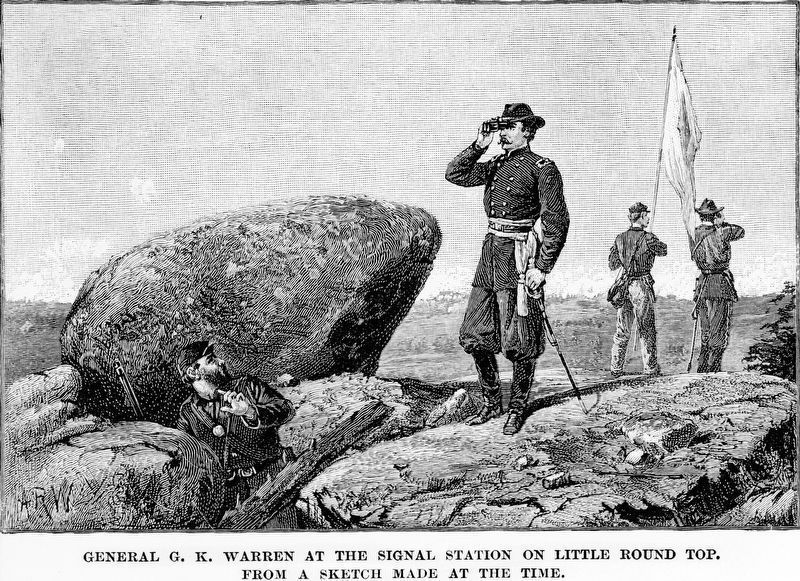
Library of Congress
5. General G.K. Warren
at the Signal Station on Little Round Top
at the Signal Station on Little Round Top
From near this point on Little Round Top, General Warren scans the horizon for attacking Confederates of Longstreet's Corps. The sight of a large enemy force about to outflank the Union position struck Warren as “almost appalling.” Behind Warren, Union signalmen use a flag to send coded messages.
Visible in the front of you is a bronze figure of General Warren standing on the boulder where he stood on July 2. The statue was dedicated in 1888.
This illustration by Alfred R. Waud appeared in Battles and Leaders of the Civil War. 1888 Vol. 3, p. 304.
Visible in the front of you is a bronze figure of General Warren standing on the boulder where he stood on July 2. The statue was dedicated in 1888.
This illustration by Alfred R. Waud appeared in Battles and Leaders of the Civil War. 1888 Vol. 3, p. 304.
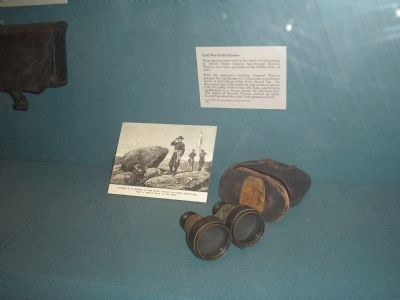
Photographed By Bill Coughlin, April 25, 2009
6. Field Glasses of Maj. Gen. Gouverneur K. Warren
These glasses, on display at the United States Military Academy at West Point, were used at the battle of Gettysburg by Brevet Major General Gouverneur Kemble Warren. On the second day of the battle, he took action to secure Little Round Top for the safety of the Union left flank.
Credits. This page was last revised on February 7, 2023. It was originally submitted on January 1, 2009, by Craig Swain of Leesburg, Virginia. This page has been viewed 1,629 times since then and 27 times this year. Photos: 1, 2, 3. submitted on January 1, 2009, by Craig Swain of Leesburg, Virginia. 4, 5. submitted on November 18, 2020, by Allen C. Browne of Silver Spring, Maryland. 6, 7. submitted on June 19, 2009, by Bill Coughlin of Woodland Park, New Jersey. 8. submitted on August 29, 2015, by Brandon Fletcher of Chattanooga, Tennessee. 9. submitted on January 4, 2013, by Mike Stroud of Bluffton, South Carolina.
